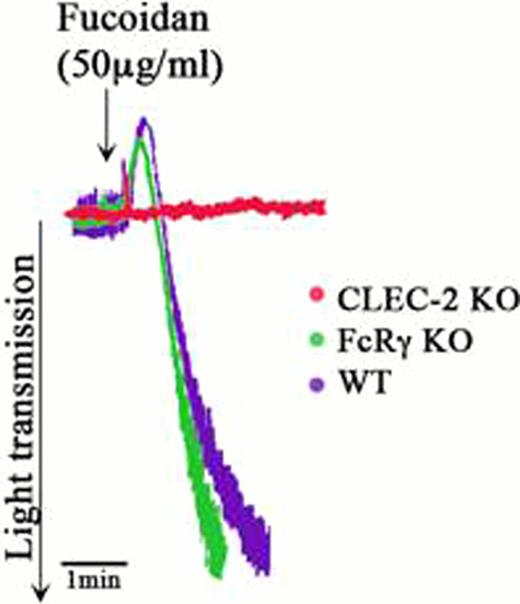Abstract
Abstract 94
Fucoidan, a sulphated polysaccharide from fucus vesiculosus, decreases bleeding time and clotting time in hemophilia, possibly through inhibition of tissue factor pathway inhibitor (TFPI) (Prasad et al., Blood 111:672, 2008). The decrease in bleeding times in the hemophilia animal models by in vivo administration of fucoidan suggests the beneficial effect of fucoidan as a novel treatment. Furthermore, in vitro studies using platelet poor plasma from hemophilia animal models and human patients has shown that fucoidan inhibits TFPI thereby contributing to an increase in the extrinsic coagulation pathway activity. The effect of fucoidan on platelets however has not been studied. As it is known that the platelet count remains unaffected in hemophilia A patients and bleeding times are primarily measured to assess normal platelet function, we hypothesize that the decrease in bleeding times in the hemophilia animal models may be due to platelet activation by fucoidan. In this study, we demonstrate for the first time that fucoidan induces platelet activation in a concentration dependent manner. Fucoidan-induced platelet activation is completely abolished by the pan-Src family kinase (SFK) inhibitor, PP2, and in the absence of Syk and PLC-g2. Furthermore, fucoidan-induced platelet activation has a lag phase, which is reminiscent of platelet activation by collagen and by CLEC-2 receptor agonists. Platelet activation by fucoidan however was only slightly inhibited in FcRg-chain null mice indicating that fucoidan is not acting primarily through GPVI receptor. On the other hand, fucoidan-induced platelet activation was inhibited in CLEC-2 deficient mouse platelets revealing CLEC-2 as a physiological target of fucoidan. Thus, our data shows fucoidan as a novel CLEC-2 receptor agonist that activates platelets through an SFK-dependent signaling pathway. Further, the efficacy of fucoidan in hemophilia raises the possibility that decreased bleeding times could be achieved through activation of platelets.
A) Fucoidan induces platelet activation: Washed aspirin-treated human platelets were stimulated with increasing concentrations of fucoidan at 37°C. Platelet aggregation was measured using a Lumi-aggregometer. The tracings are representative of data from at least three independent experiments.
B) Effect of SFK inhibition on fucoidan-induced platelet activation: Washed aspirin-treated human platelets were pre-treated with SFK inhibitor PP2 10uM or PP3 (vehicle) at 37°C for 5 min followed by stimulation with fucoidan (50 ug/ml) for 3 minutes under stirred conditions. Platelet aggregation was measured using Lumi-aggregometer and effect on phosphorylation of Syk (Y525/26) and LAT (Y191) in the presence of SFK inhibitor PP2 an PP3 (control) were analyzed. The results are representative of data from platelets at least three independent experiments.
C) Identifying a possible receptor for fucoidan on platelets: Wild type, FcRg-chain or CLEC-2 null murine platelets were stimulated with fucoidan (50 ug/ml) at 37°C under stirred conditions and aggregation was measured using Lumi-aggregometer.
A) Fucoidan induces platelet activation: Washed aspirin-treated human platelets were stimulated with increasing concentrations of fucoidan at 37°C. Platelet aggregation was measured using a Lumi-aggregometer. The tracings are representative of data from at least three independent experiments.
B) Effect of SFK inhibition on fucoidan-induced platelet activation: Washed aspirin-treated human platelets were pre-treated with SFK inhibitor PP2 10uM or PP3 (vehicle) at 37°C for 5 min followed by stimulation with fucoidan (50 ug/ml) for 3 minutes under stirred conditions. Platelet aggregation was measured using Lumi-aggregometer and effect on phosphorylation of Syk (Y525/26) and LAT (Y191) in the presence of SFK inhibitor PP2 an PP3 (control) were analyzed. The results are representative of data from platelets at least three independent experiments.
C) Identifying a possible receptor for fucoidan on platelets: Wild type, FcRg-chain or CLEC-2 null murine platelets were stimulated with fucoidan (50 ug/ml) at 37°C under stirred conditions and aggregation was measured using Lumi-aggregometer.
No relevant conflicts of interest to declare.
Author notes
Asterisk with author names denotes non-ASH members.




This feature is available to Subscribers Only
Sign In or Create an Account Close Modal